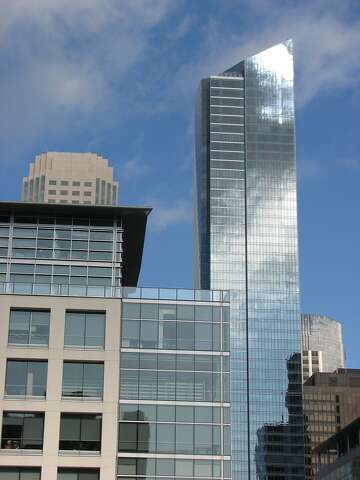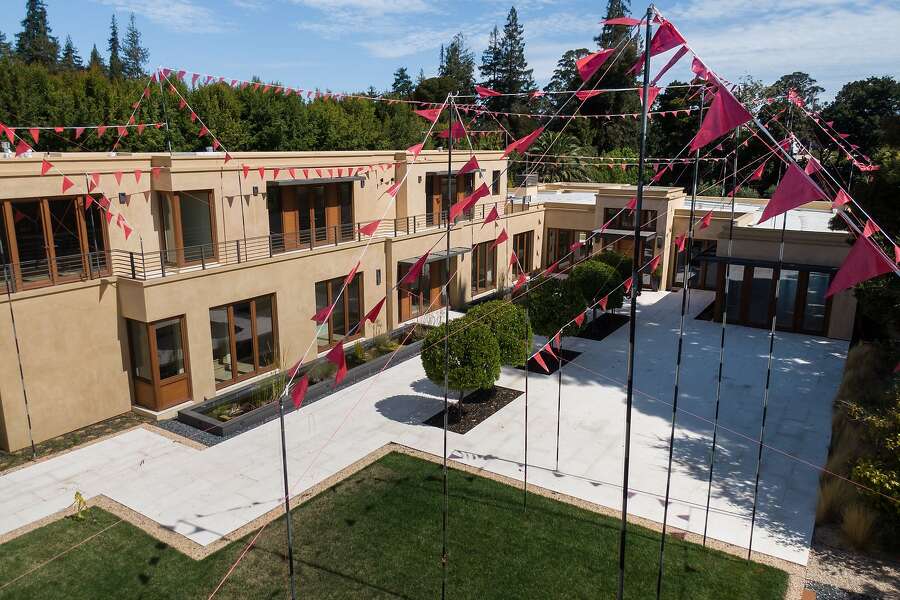SF’s landmark tower for rich and famous is sinking and tilting
The Millennium Tower, a leading symbol of San Francisco’s new high-rise and high-end living, is sinking — setting the stage for what could be one of the most contentious and costly real estate legal battles the city has ever seen.
Rated by Worth magazine as one of the top 10 residential buildings in the world, the Millennium at 301 Mission St. is home to such A-listers as Joe Montana and Hunter Pence. Until his recent death, it’s where venture capitalist Tom Perkins owned a penthouse. Condos sell for anywhere from $1.6 million to north of $10 million.
However, since its completion in 2008, the 58-story building has sunk 16 inches, according to an independent consultant hired to monitor the problem. It has also tilted 2 inches to the northwest.
“That’s significant ... and of concern,” said Professor Greg Deierlein, director of the John A. Blume Earthquake Engineering Center at Stanford University, who has been called in to evaluate the designs of a couple of San Francisco’s newer downtown high-rises.
Deierlein noted that the 88-story Petronas Twin Towers in Malaysia — which were the world’s tallest buildings when they opened in 1998 — have sunk less than 3 inches. Their tilt, or “differential settlement,” is less than half an inch.

This isn’t just an issue for the Millennium’s owners and wealthy inhabitants: It could be a headache for taxpayers as well. There are potentially big public dollars at stake, with the owners alleging that the massive hole dug next door for the new Transbay Transit Center is to blame for the building’s issues.
The problem first came to light in 2010 when the Transbay Joint Powers Authority, the public agency constructing the transit center, hired the consulting firm Arup to gauge how the excavation could affect the tower.
According to the consultant’s initial report, by the time excavation began — two years after the $350 million Millennium was completed — the tower had already settled 10 inches. That was 4 inches more than its builders had predicted for the life of the high-rise.
Since then, “the building has continued to settle vertically, now 16 inches,” representatives of the Transbay Joint Powers Authority said in a statement in response to questions from The Chronicle.
At the same time, geotechnical reports show that since 2009, the settling has been uneven — resulting in the 2-inch tilt.
And while Stanford’s Deierlein doesn’t consider the sink or tilt a safety issue, he did say, “I would be concerned for my investment.” That’s because a shifting building can cause walls to crack, elevators to malfunction and all manner of other annoyances.
P.J. Johnston, spokesman for tower builder Millennium Partners and its principal owner, Sean Jeffries, said a nine-month, independent structural safety review in 2014 “determined the settlement has not significantly affected the seismic performance of the building, and does not represent a safety risk.”
An attorney for the Millennium homeowners association’s board, John Gill, recently sent a confidential letter to some of the more than 400 residents saying the board was “actively engaged in negotiations with Millennium Partners to resolve building settlement issues.” The letter also said the association was “sensitive to the concerns of everyone about any issue which could impact the value of their units.”
In a statement Friday, homeowner representatives said they had “retained a number of engineering consultants to investigate the causes and long-term impact of these settlement conditions” and were evaluating their legal options. They cited any number of parties that could be held “legally accountable” — including the developer, the high-rise’s designers, the contractors and the Transbay Joint Powers Authority, which is run by San Francisco, AC Transit, Caltrans and the agency that operates Caltrain.
For his part, Millennium spokesman Johnston wasted no time blaming the transit center authority. He insisted that the tower’s settling had been within normal range until excavation began on the bus and rail center next door.
“They built a half-mile tunnel 60 feet underground and next to our building, and they were supposed to (protect the Millennium) — and they didn’t,” Johnston said.
The authority also signed an agreement with the Millennium developer in 2008 “to repair, at its own cost and expense ... any damage to the development substantially caused by TJPA’s construction activities,” according a copy of the agreement on file at San Francisco City Hall.
Records show the Transbay Joint Powers Authority pumped more than $58 million into an underground buttressing system to shore up the Millennium before beginning excavation in 2010. That’s one of the many reasons for the new transit center’s spiraling costs, which are now at $2.4 billion and counting.
In its statement, the transit center authority said it “bears no responsibility for the tilt and excessive settlement.”
Unlike some downtown high-rises, the Millennium isn’t steel-framed. Instead, the developer chose a concrete design more common to residential buildings. It relies on huge columns, shear walls and beams, and it’s much heavier than steel. What’s more, the building is located on unstable mud-fill, just off the bay’s original shoreline.
The Millennium’s engineers anchored the building over a thick concrete slab with piles driven roughly 80 feet into dense sand. “To cut costs, Millennium did not drill piles to bedrock,” or 200 feet down, the transit center authority said in its statement. Had it done so, the agency said, “the tower would not be tilting today.”
Johnston countered that “virtually all other buildings in that part of the city have their foundations at the same subterranean level,” citing skyscrapers that include the St. Regis and Intercontinental hotels.
He added that the Millennium’s design was state of the art for residential buildings and that concrete can be preferable to steel for several reasons, including sound insulation.
“In any case, this was not a cost-saving decision, but the preferred design,” Johnston said.
While there have been reports of cracks appearing in the Millennium’s underground garage, there’s no word of residents complaining about damage to their condos. Instead, the shifting and sinking of the concrete platform beneath the building has necessitated what Johnston called “minor repairs to sidewalks and connections at the ground level.”
Experts tell us it’s uncertain exactly what, if anything, can be done to fix the problem or straighten the tower. There has been talk of pumping cement underneath the base and drilling new piles — complicated and expensive undertakings.
An assessment, no doubt, that offers little comfort to those living in the building.
San Francisco Chronicle columnists Phillip Matier and Andrew Ross appear Sundays, Mondays and Wednesdays. Matier can be seen on the KPIX TV morning and evening news. He can also be heard on KCBS radio Monday through Friday at 7:50 a.m. and 5:50 p.m. Got a tip? Call (415) 777-8815, or email matierandross@sfchronicle.com. Twitter: @matierandross






























































